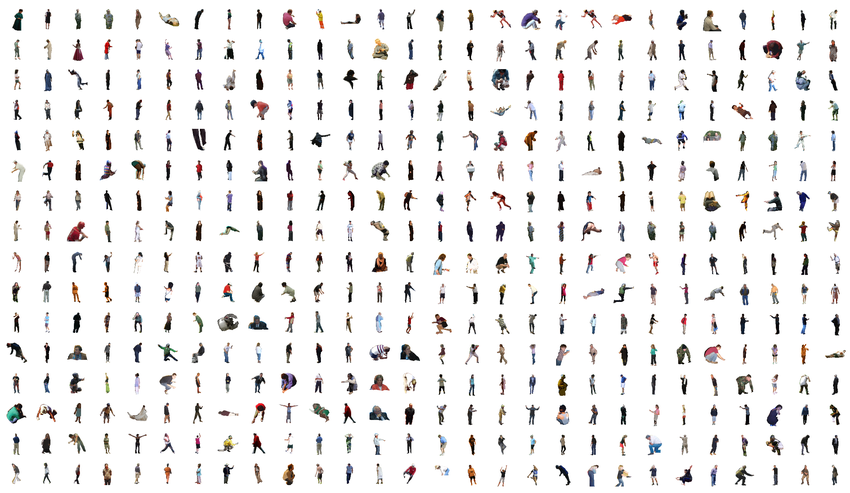User:Manetta/meta-mining/the-friendly-flickr-bot: Difference between revisions
(Created page with "<div style="width:100%;max-width:850px;"> __NOTOC__ =H.I.T. Human Intelligence Tasks= recognizing human labour in image classification File:HIT-press-image landscape.png|85...") |
No edit summary |
||
| Line 10: | Line 10: | ||
H.I.T. is a game show that performs the production of computer vision algorithms and turns cogntive labour into cash prizes. To investigate the position of human labour in such productions, the artists Max Dovey & Manetta Berends have adapted the (recently implied) automatic image tagging application from Flickr into a participatory game show. Following the individual steps in developing such a recognition system, the role of human labour in the production of algorithms will be revealed. Through a series of tasks, multiple teams are competing to identify the human labour involved in the development of an image recognition algorithm. | H.I.T. is a game show that performs the production of computer vision algorithms and turns cogntive labour into cash prizes. To investigate the position of human labour in such productions, the artists Max Dovey & Manetta Berends have adapted the (recently implied) automatic image tagging application from Flickr into a participatory game show. Following the individual steps in developing such a recognition system, the role of human labour in the production of algorithms will be revealed. Through a series of tasks, multiple teams are competing to identify the human labour involved in the development of an image recognition algorithm. | ||
With the advancement of artificial intelligent systems, computers are increasingly required to perform cognitive acts. Human labour becomes an intergral computational component in the form of microwork such as 'crowdsourcing' and Amazon's 'Mechanical Turk'. The outcome of this unregulated labour becomes the basis for popular image recognition algorithms, such as Flickr's auto tagging service. In Flickr's case, the image-tag relations are first manually created through H.I.T.'s, human intelligence tasks performed by Mechanical Turks. Later, Flickr's tagging application is learning from the data of the masses, by smartly using the adjustments to tags by users themselves. How does the manual labour influence the machine learning process and how can | With the advancement of artificial intelligent systems, computers are increasingly required to perform cognitive acts. Human labour becomes an intergral computational component in the form of microwork such as 'crowdsourcing' and Amazon's 'Mechanical Turk'. The outcome of this unregulated labour becomes the basis for popular image recognition algorithms, such as Flickr's auto tagging service. In Flickr's case, the image-tag relations are first manually created through H.I.T.'s, human intelligence tasks performed by Mechanical Turks. Later, Flickr's tagging application is learning from the data of the masses, by smartly using the adjustments to tags by users themselves. How does the manual labour influence the machine learning process and how can H.I.T. be performed to evaluate the human position in developing such systems? | ||
==notes== | ==notes== | ||
Revision as of 17:01, 20 November 2015
H.I.T. Human Intelligence Tasks
recognizing human labour in image classification
abstract
H.I.T. is a game show that performs the production of computer vision algorithms and turns cogntive labour into cash prizes. To investigate the position of human labour in such productions, the artists Max Dovey & Manetta Berends have adapted the (recently implied) automatic image tagging application from Flickr into a participatory game show. Following the individual steps in developing such a recognition system, the role of human labour in the production of algorithms will be revealed. Through a series of tasks, multiple teams are competing to identify the human labour involved in the development of an image recognition algorithm.
With the advancement of artificial intelligent systems, computers are increasingly required to perform cognitive acts. Human labour becomes an intergral computational component in the form of microwork such as 'crowdsourcing' and Amazon's 'Mechanical Turk'. The outcome of this unregulated labour becomes the basis for popular image recognition algorithms, such as Flickr's auto tagging service. In Flickr's case, the image-tag relations are first manually created through H.I.T.'s, human intelligence tasks performed by Mechanical Turks. Later, Flickr's tagging application is learning from the data of the masses, by smartly using the adjustments to tags by users themselves. How does the manual labour influence the machine learning process and how can H.I.T. be performed to evaluate the human position in developing such systems?
notes
no ne
* 'i-could-have-written-that' #0.1: heteromation
* 'notes on the Friendly Flickr Bot'

